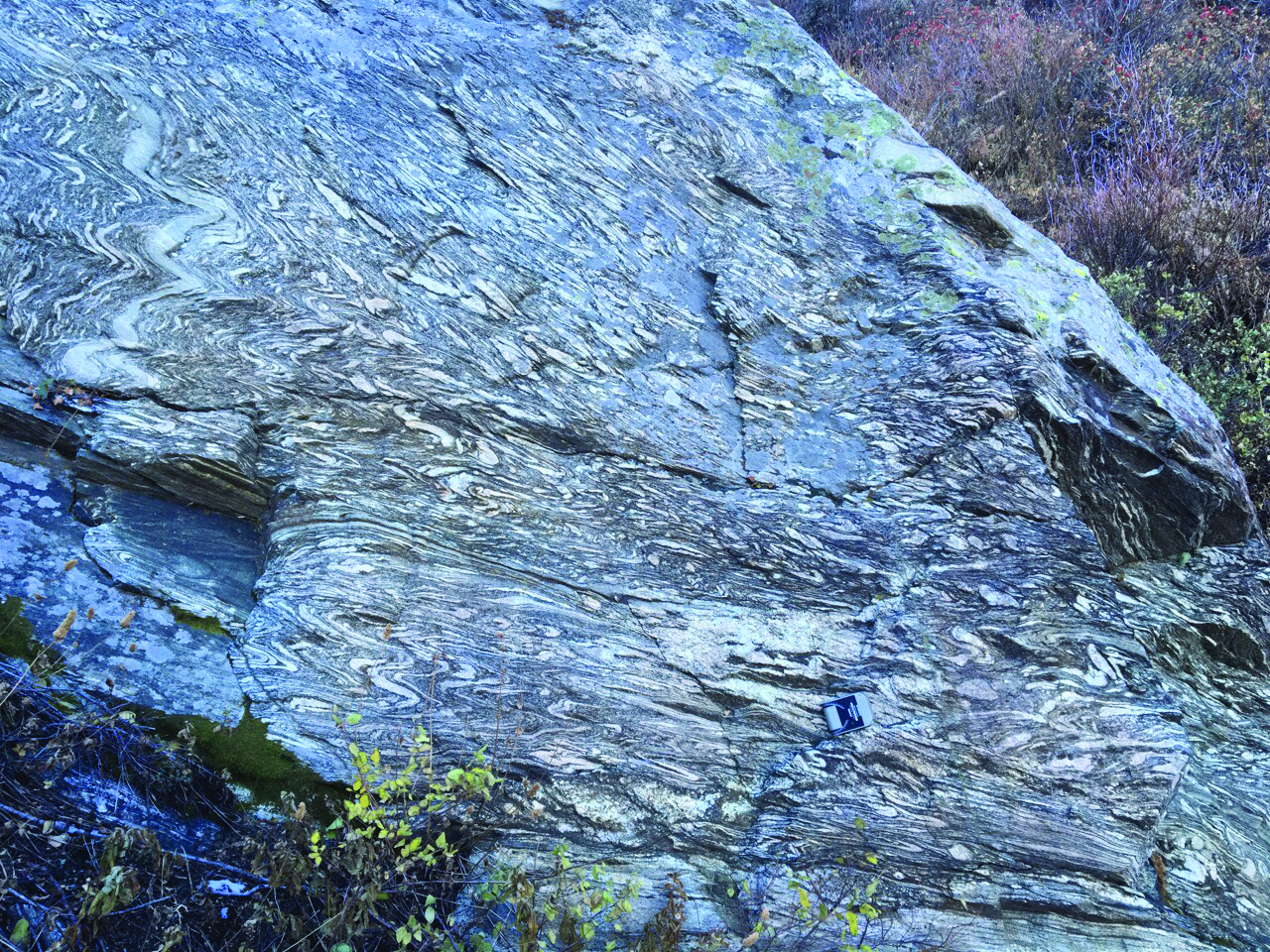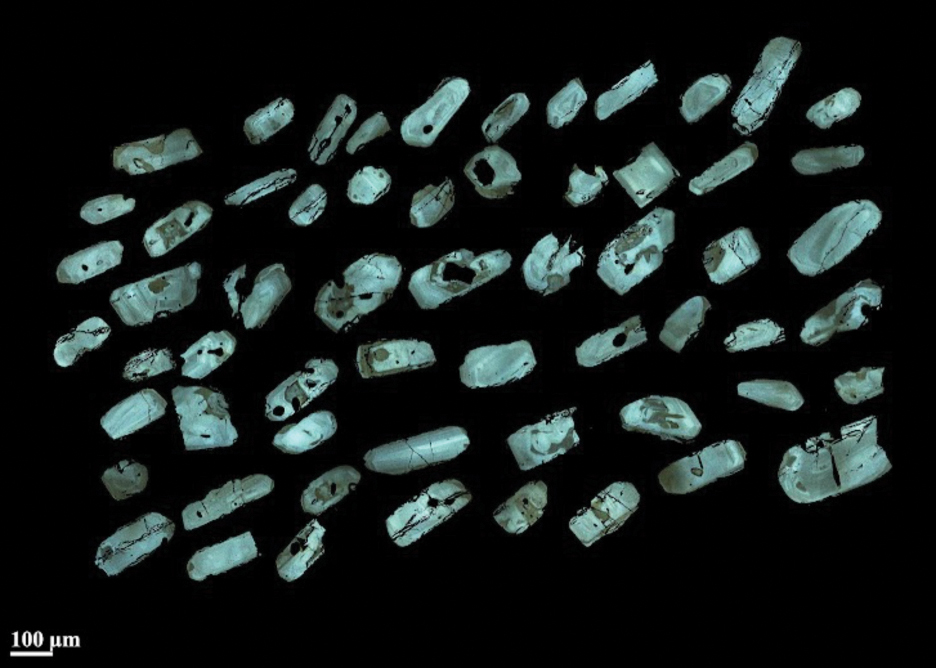Glad You Asked: What are the Oldest Rocks in Utah?
by Stephanie Carney
Utah’s oldest rocks formed during the Precambrian, a time in Earth’s history that occurred 4,600 to 540 million years ago and was characterized by simple, single-celled organisms before the “Cambrian Explosion” of complex organisms around 540 million years ago. Many of Utah’s Precambrian outcrops are well studied and have been radiometrically dated. The results of these studies and analyses indicate that the oldest known rocks in Utah belong to the Green Creek Complex in northwestern Utah.
The Raft River and Grouse Creek Mountains in Box Elder County are home to the Green Creek Complex, which comprises a 2.7-billion-year-old (Ga) schist (metamorphosed sedimentary rock) and a 2.5 Ga monzogranite (an igneous pluton that intruded the schist). These rocks were deposited and formed during the late Archean Eon of the Precambrian. The schist originated as sediments deposited on a passive margin (where virtually no tectonic activity is taking place, like the present-day Atlantic Coast) of the North American craton (the ancient core of the North American continent). The 2.7-Ga age records the maximum time of deposition of these sedimentary rocks. The monzogranite began as a magma body that intruded into the older sedimentary rocks from below, therefore sedimentation took place between 2.7 and 2.5 Ga. The minerals that make up the granite slowly crystalized as the magma body cooled in the subsurface, and the 2.5-Ga age records when the minerals formed.
The rocks of the Green Creek Complex were subjected to multiple metamorphic events since 2.5 Ga. The first of these events was when the Grouse Creek block, a tectonic terrane which the Green Creek rocks are a part of, collided with the North American craton around 1.7 billion years ago during the early Proterozoic Eon of the Precambrian. The rocks also record later metamorphic events that affected the complex during the Late Cretaceous Period, around 95 and 82 million years ago. These later events would have been related to the Sevier orogeny, which was a mountain building event that lasted from about 160 to 80 million years ago.
Other Noteworthy Precambrian-age Rocks in Utah

Outcrop of the Farmington Canyon Complex gneiss in the Wasatch Range. Compass for scale. Photo courtesy of Zach Anderson, Utah Geological Survey.
The Farmington Canyon Complex is not quite as old as the Green Creek Complex, but is more accessible to Utahns, especially those living along the Wasatch Front. The Farmington Canyon Complex is exposed in the Wasatch Range east of Ogden, Layton, and Farmington, as well as on Antelope Island in Great Salt Lake, and consists of a suite of metamorphic rocks including schist, gneiss, and quartzite. Zircons from the Farmington Canyon Complex have yielded ages of about 2.4 Ga and the rocks were subjected to the same metamorphic event that affected the Green Creek Complex 1.7 billion years ago. The Frary Peak trail on Antelope Island winds through some of these impressively metamorphosed rocks.
Other notable Precambrian rocks are the Red Creek Quartzite and the Owiyukuts Complex, in the eastern Uinta Mountains; metamorphic rocks in the Beaver Dam Mountains in southwestern Utah; and metamorphic rocks in east-central Utah. The Red Creek Quartzite is in Daggett County near Clay Basin and the Wyoming and Colorado borders. It is composed of the metamorphic rocks quartzite, mica schist, and amphibolite and has yielded metamorphic ages around 1.7 Ga. A little south and east of the Red Creek outcrops is a relatively small exposure of highly metamorphosed gneiss called the Owiyukuts Complex. The gneiss there has yielded a metamorphic age of about 1.8 Ga.
In southwestern Utah, ancient metamorphic gneiss, schist, and pegmatite are exposed in the Beaver Dam Mountains west of St. George. These rocks have a metamorphic age of about 1.8 to 1.7 Ga as well. Similarly, Precambrian gneiss, schist, and amphibolite rocks near Westwater Canyon of the Colorado River and the Coach Canyon area near the Utah-Colorado border in eastern Utah have metamorphic ages of about 1.7 Ga.
How Are Ages Determined?

Example of zircon grains under cathodoluminescence microscope. Photo courtesy of Dr. Liz Balgord of Weber State University.
Radiometric or isotopic dating is one of the best ways to determine the age of an igneous or metamorphic rock. This dating technique measures how much of a radioactive isotope of an element has decayed over time. An isotope is a different form of the same chemical element; i.e., it is the same element but has a different mass (extra neutrons). An unstable or radioactive isotope (called a parent isotope) is one that decays over time to become a different stable elemental isotope (daughter isotope). The length of time it takes for one-half of the parent isotope to decay into its daughter isotope is called the half-life. For example, the unstable argon isotope 39Ar will decay to the stable form of 39K and has a half-life of 269 years, and the unstable samarium isotope 147Sm will decay to stable neodymium (143Nd) and has a half-life of 106 billion years!
One of the most reliable methods for determining the age of very old rocks is uranium-lead (U-Pb) zircon geochronology. Igneous rocks often contain the mineral zircon, which is an accessory mineral that crystallizes at high temperature inside a magma body. During crystallization, zircon incorporates uranium in its crystal structure but not lead. Lead is created and added to the crystal solely from the radioactive decay of uranium. Uranium has two radioactive isotopes, 238U and 235U. The isotope 238U decays to 206Pb and has a half-life of 4.47 billion years, and 235U decays to 237Pb and has a half-life of 710 million years. Because these two different decay series occur in the zircon, two ages can be determined by measuring the ratio of parent and daughter isotope for each decay track. The results of each measurement can then be compared to verify the age of the mineral and, therefore, the rock.
An approximate age for sedimentary rocks can also be obtained using zircon geochronology. Zircon is a durable and hard mineral, and grains that have weathered out of igneous rocks are often deposited along with other minerals and sediments that eventually will form a sedimentary rock. A maximum age of the sedimentary rock can be determined from the age of the zircons within it. The age of the zircon grains can also point to where they came from, or their provenance, by comparing them to other known ages of local or regional igneous rocks.











